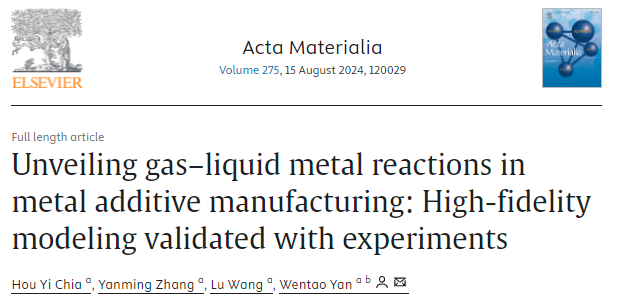Unveiling Gas-liquid Metal Reactions in Metal Additive Manufacturing: High-fidelity Modeling Validated with Experiments
A research team led by Assistant Professor Yan Wentao, the Principal Investigator from the Energy and Environmental Nanotech Research Platform of NUSRI Suzhou, has published their results in the journal Acta Materialia. The team has clarified the mass transfer process of oxygen during metal AM through high-fidelity modeling by considering the competition between diffusion and chemical reaction, suboxide evaporation, and the influence of the vapor plume. This work provides not only solid theoretical foundation for metal AM, but also useful guidance to optimise the AM processes and to synthesise new materials with more freedoms of reducing or increasing oxidation.

Additive manufacturing (AM) is an increasingly popular and viable manufacturing technology. Amongst various AM techniques, the laser powder bed fusion (LPBF) process is well received as it enables the manufacturing of parts with complex geometries with micron-scale precision. During the LPBF process, the surface of the melt pool is highly reactive with gases available in the manufacturing chamber. Oxygen is especially reactive with liquid metals, and oxidation of the liquid melt in AM may lead to poor wetting, balling, and even cracks, resulting in poor consolidation and failed builds. Thus, inert atmospheres are generally preferred to minimise gas-liquid metal reactions, although complete elimination remains impossible. Guided by deepening understanding into the gas-liquid metal reactions, the AM community has started exploiting the inevitable reactivity of the melt with the atmosphere to generate beneficial in-situ nucleations and precipitations to enhance the material properties, e.g., synthesising in-situ oxide dispersion-strengthened (ODS) materials. However, the gas-liquid metal reaction and mechanisms in both scenarios remain unclear. Experimental works hitherto provide different explanations to the same phenomena.
Therefore, the research team led by Assistant Professor Yan Wentao seeks to clarify the mass transfer process of oxygen during metal AM through high-fidelity modeling by considering the competition between diffusion and chemical reaction, suboxide evaporation, and the influence of the vapor plume. The simulation results, validated with experiments, provide consolidated insights into the oxygen evolution behaviour during metal AM. Counterintuitively, higher melt pool temperatures do not necessarily lead to greater oxidation rates during processing. The melt pool has regions of high and low oxygen gains due to temperature-dependent reaction regimes, with concurrent oxygen loss from evaporation of metal suboxides. Thus, the net oxygen flux varies for different materials, and the oxygen content cumulatively changes as multiple tracks are scanned.
Overall, this work provides useful guidance to the AM community that seeks to ameliorate or exploit the inevitable gas-liquid interaction in metal AM, so that the manufacturing parameters can be optimised accordingly to achieve the desired microstructure and properties. Moreover, cost-saving measures may be possible for determining the purity of shielding gas used in AM, and physics-guided measures can be taken to limit or control gas-liquid metal reaction. The multi-physics model is generally applicable to various metals and gases, and shows appealing potentials in facilitating the wide adoption of AM in a much broader range of materials.




